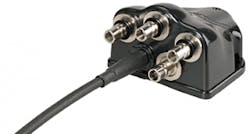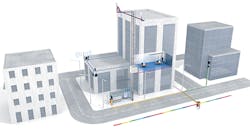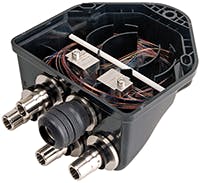Latest from 5G/6G & Fixed Wireless Access/Mobile Evolution
Chasing Coverage and Capacity?
Try These 5 Best Scenarios for Small Cell Deployment
In today’s world, people expect to be connected wherever, whenever. This demand and expectation has made the need to improve cellular and fixed broadband coverage increasingly urgent and has forced carriers to add capacity to their networks by providing coverage across multiple spectrums. This is particularly necessary in urban areas where high capacity and data rates are needed.
This small cell cable system allows to build up simple and fast a daisy chain.
Usually, the best way to achieve this would be to deploy fiber networks. However, this is not always possible nor the most viable option due to the architecture of these networks. Instead, the most efficient way for carriers to achieve this is to re-use frequency of all existing cells and improve their macro layer, densify their macro cells, and install significantly more indoor and outdoor small cell networks.
Small cells (low-powered outdoor access nodes with a typical range of 10 to several hundred meters) provide a flexible solution with increased Quality of Service capabilities in a cost-effective way. According to a Rethink Research report, Small Cells Deployments and Installed base September 2015, the deployment of small cells for carriers will continually grow until 2019, with the highest compound annual growth rate (CAGR) predicted to reach 92% in urban areas.
With their ability to be deployed discretely in urban streets as well as in buildings such as airports, train stations, shopping malls, and sports stadiums, small cells are improving coverage in locations that are otherwise difficult to reach using traditional macro cells. Although macro cells are much more powerful and have greater bandwidth than small cells, small cells can add capacity and improve the performance of the macro network and even handle large percentages of data when multiple small cells are placed in a macro area.
Small Cell networks are deployed in- and outdoor to increase coverage in crowded buildings and places like bus stations.
Of course, the most important factor for wireless operators and subscribers is the actual performance of the network, and small cell base stations provide higher capacity than macro cells simply because of the way they are deployed. Mounted low above ground and below building rooflines, small cells are less susceptible to interference, and this translates directly into higher capacity. Better signal quality leads to increased throughput where more data can be transmitted at the same time. Therefore, the areas where users can transmit and receive at a higher data rate are larger in a small cell than a macro cell.
Using HUBER+SUHNER network cubes (WDMs), mobile operators can maximize return on investment of their fiber infrastructure by adding more bandwidth over existing infrastructure easily.
Another significant advantage of small cells is that they provide a cleaner signal with less power and, because they can be placed strategically in a network, they can provide good coverage for less power trade-off. This can reduce the number of cell towers.
With additional benefits such as lower latency for data services, faster download and upload time, significant source of revenue, and better cell edge performance, it is easy to see why the industry is seriously considering small cell solutions.
However, small cell deployment does not come without its challenges — like the backhauling in dense urban areas, municipal regulations regarding the look, size and colour of equipment, as well as the installations on streetlights, street furniture, utility poles, and building sides. Therefore, not only a viable business model but also easy-to-install modular solutions are needed to secure the fast and reliable deployment of small cell networks.
Given our experience in remote radio installation solutions, we recommend that providers first embrace these 5 scenarios as they work to roll-out small cells for both capacity and coverage:
Scenario 1. Small cell daisy chain composed of pre-terminated fiber optic cable systems for a main station in a city.
Scenario 2. Small cell solutions for kiosks at bus stations with fiber optic cabling systems, broadband antennas, and RF connections.
Scenario 3. Small cell network installation at a busy main place in a city centre.
Scenario 4. Wavelength-division multiplexing (WDM) daisy chain utilising dark fiber.
Scenario 5. WDM to single point on a telephone pole.
Endnote
To read the Rethink Research report, Small Cells Deployments and Installed base September 2015, please visit http://www.rethinkresearch.biz/wp-content/uploads/2015/09/Small-Cells-deployments-and-Installed-base-September-2015-Brochure.pdf.








